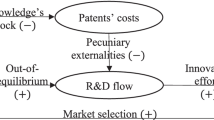Abstract
Over the centuries, world economic system and the corresponding economic structure have been in a state of continuous evolution. In this paper, through the empirical analysis on the evolution history of world economic structure, we show that the underlying driving force for the evolution of world economic structure is Technology Innovation. Specifically, we find that symmetry breakings not only emerge in the whole economic structure, but also take place in the local economic relation and economic status of inner countries along the long evolution history of world economic structure. We also elaborate the detailed mechanism of symmetry breaking of world economic structure. That is, in the evolution of world economic structure, all those countries participating in world economic open market are affected to varying degrees by symmetry breaking that is caused by technology innovation, which eventually determines current world economic structure with competitive countries evolving into economic centers and countries completely marginalized evolving into ‘singularities’ of world economic network.
Access this chapter
Tax calculation will be finalised at checkout
Purchases are for personal use only
Preview
Unable to display preview. Download preview PDF.
Similar content being viewed by others
References
Wallerstein, L.: The Capitalist-World Economy. Cambridge University Press, Cambridge (1979)
Amin, S.: Class and Nation: Historically and in the Current Crisis. Monthly Review Press, New York (1980)
Chase-Dunn, C.: Global Formation: Structures of the World Economy. Basil Blackwell, Oxford (1989)
Frank, A.G.: Capitalism and Underdevelopment in Latin America. Monthly Review Press, New York (1967)
Hirschman, A.O.: National power and the structure of foreign trade. University of California Press, Berkeley (1980)
Hollist, W.L.: Conclusion: anticipating world system theory synthesis. International Studies Quarterly 25, 149–160 (1981)
Chase-Dunn, C.: Global formation: structures of the world-economy. Basil Blackwell Inc., New York (1989)
Rubinson, R.: Dynamics of World Development. Sage Publications, Beverly Hills (1981)
Arrighi, G.: Transforming the Revolution: Social Movements and the World System. Monthly Review Press, New York (1990)
Arrighi, G., Drangel, J.: The stratification of the world-economy: an exploration of the semiperipheral zone. Review 10(1), 9–74 (1986)
Ekholm, K., Friedman, J.: Toward a Global Anthropology. Critique of Anthropology 5(1), 97–119 (1985)
Cox, R.: Social Forces, States and World Orders: Beyond International Relations Theory. Millennium: Journal of International Studies 10(2), 126–155 (1981)
Cox, R.: Multinationalism and World Order. Review of International Studies 18, 161–180 (1992)
Cox, R.: Production, Power, and World Order: social forces in the making of history. Columbia University Press, New York (1987)
Xiao, Y.H., MacArthur, B.D., Wang, H., Xiong, M.M., Wang, W.: Network Quotient: Structural Skeletons of Complex Systems. Physical Review E 78, 046102 (2008)
Xiao, Y.H., Wu, W.T., Wang, H., Xiong, M.M., Wang, W.: Symmetry-based Structure Entropy of Complex Networks. Physica A 387, 2611–2619 (2008)
Xiao, Y.H., Xiong, M.M., Wang, W., Wang, H.: Emergence of Symmetry in Complex Networks. Physical Review E 77(6), 066108(2008)
Wang, H., Yan, G.l., Xiao, Y.H.: Symmetry in World Trade Network. Journal of Systems Science and Complexity (in press) (2008)
Wigner, E.P.: Symmetries and reflections: Scientific essays. MIT Press, Cambridge (1970)
Zee, A.: Fearful symmetry: The search for beauty in modern physics. Princeton Univ. Press, Princeton (1999)
Xu, G.Z., Gu, J., Che, H.A.: System Science (in Chinese). Shanghai Scientific and Technological Education Publishing House, Shanghai (2000)
Schumpeter, J.A.: Theoretical Problems: Theoretical Problems of Economic Growth. Journal of Economic History 7 (1947)
Reuveny, R., Thompson, W.: Leading sectors, lead economies and economic growth. Review of International Political Economy 8(4), 689–719 (winter 2001)
Rennstich, J.K.: The new economy, the leadership long cycle and the nineteenth K-wave. Review of International Political Economy, Match, 150–182 (2002)
Mendez, R.: Creative Destruction and the Rise of Inequality. Journal of Economic Crowth 7, 259–281 (2002)
Pohjola, M.: The New Economy: facts, impacts and policies. Information Economics and Policy, 133–144 (2002)
Author information
Authors and Affiliations
Editor information
Editors and Affiliations
Rights and permissions
Copyright information
© 2009 ICST Institute for Computer Science, Social Informatics and Telecommunications Engineering
About this paper
Cite this paper
Wang, H., Yan, G. (2009). Symmetry Breaking in the Evolution of World Economic Structure. In: Zhou, J. (eds) Complex Sciences. Complex 2009. Lecture Notes of the Institute for Computer Sciences, Social Informatics and Telecommunications Engineering, vol 4. Springer, Berlin, Heidelberg. https://doi.org/10.1007/978-3-642-02466-5_93
Download citation
DOI: https://doi.org/10.1007/978-3-642-02466-5_93
Publisher Name: Springer, Berlin, Heidelberg
Print ISBN: 978-3-642-02465-8
Online ISBN: 978-3-642-02466-5
eBook Packages: Computer ScienceComputer Science (R0)




